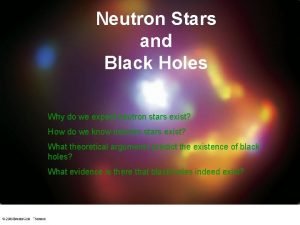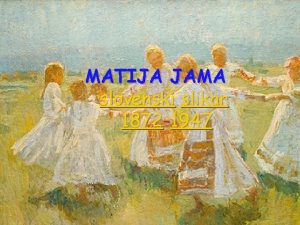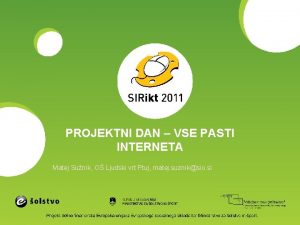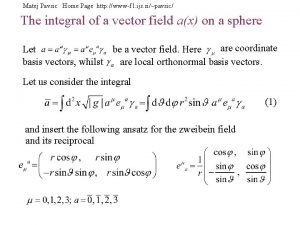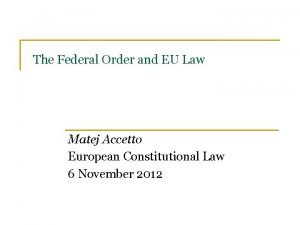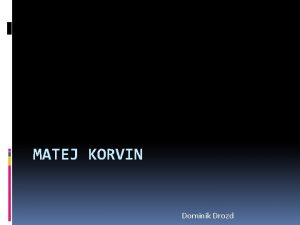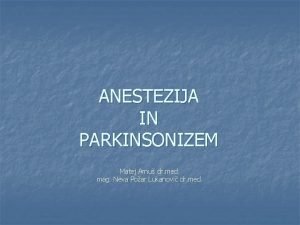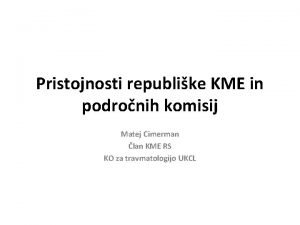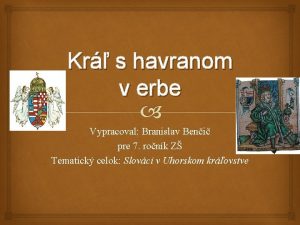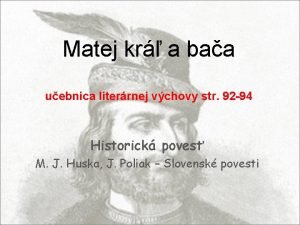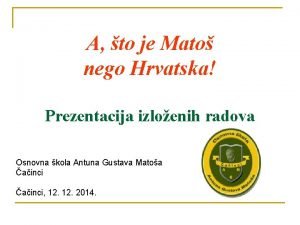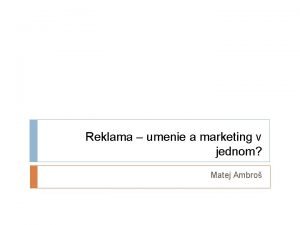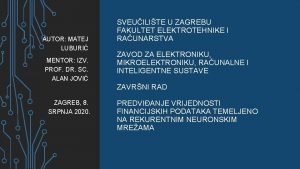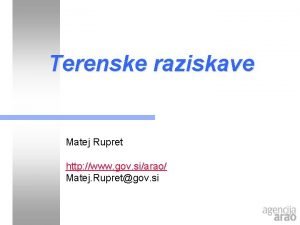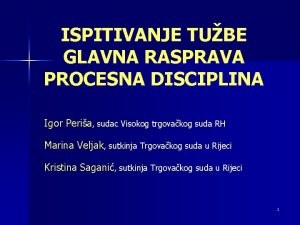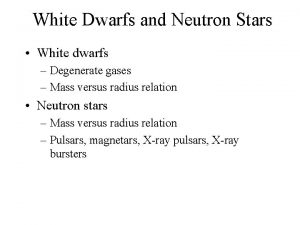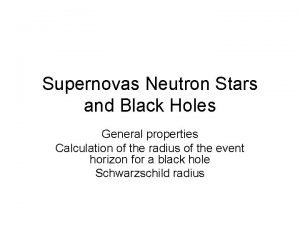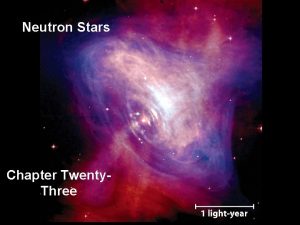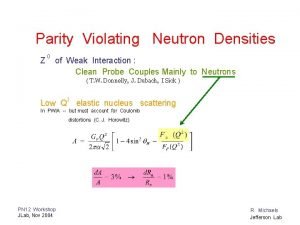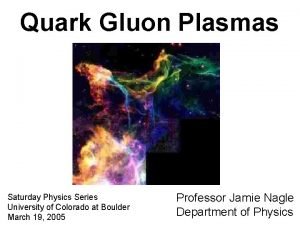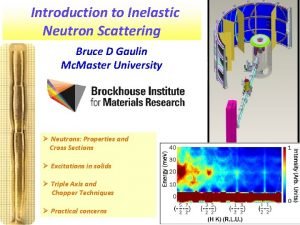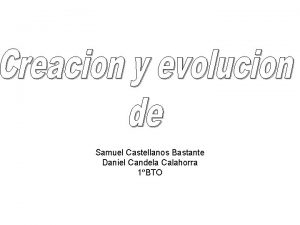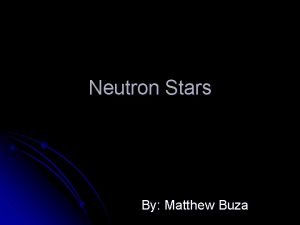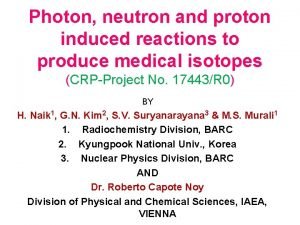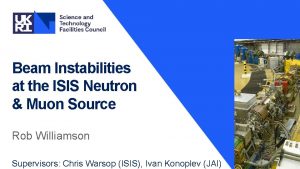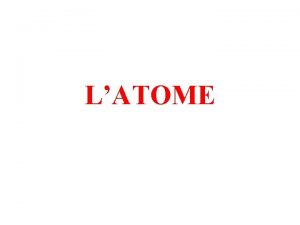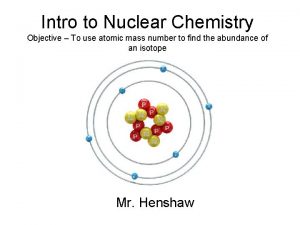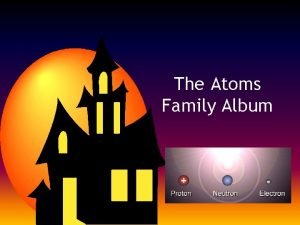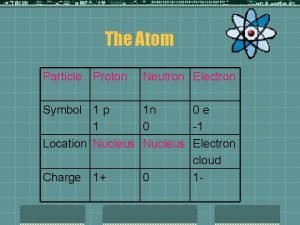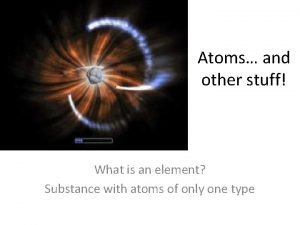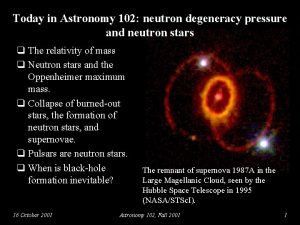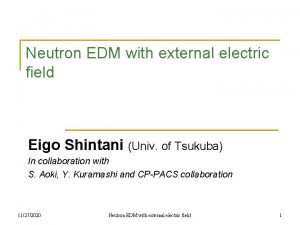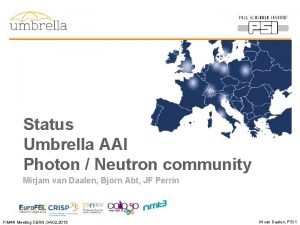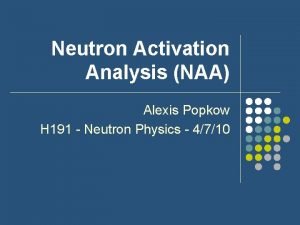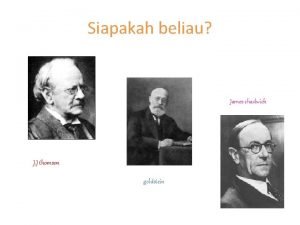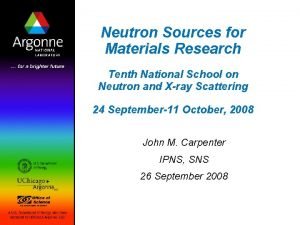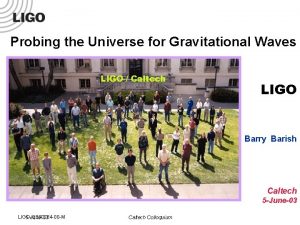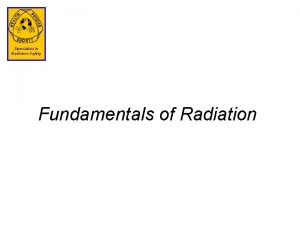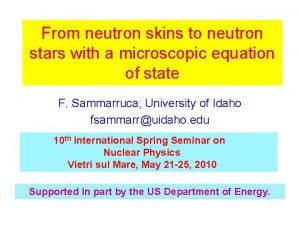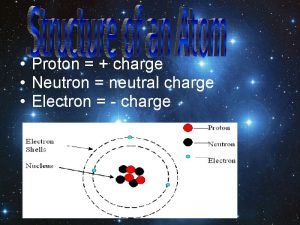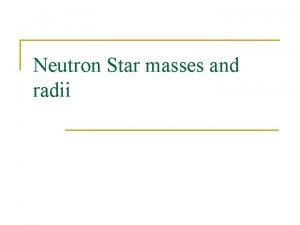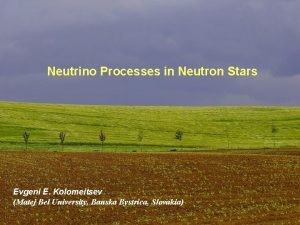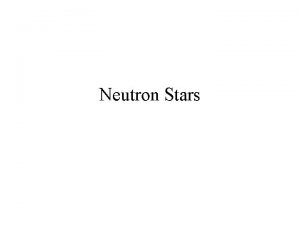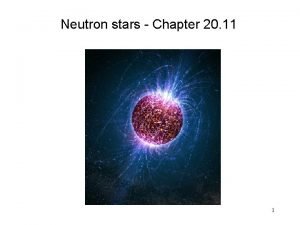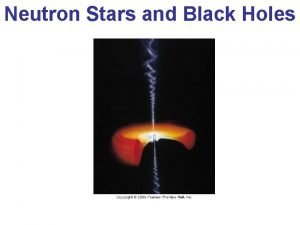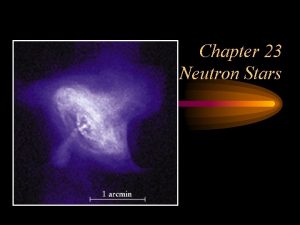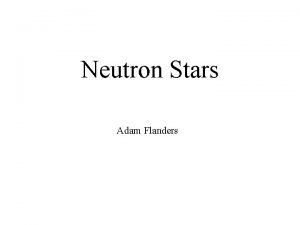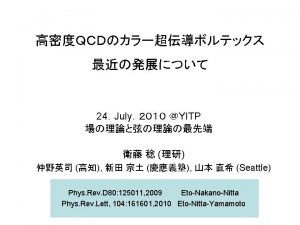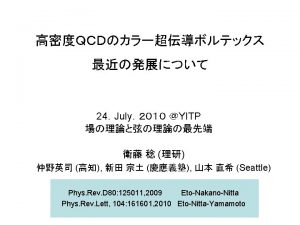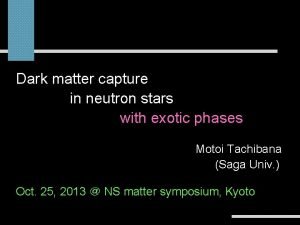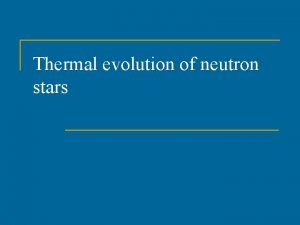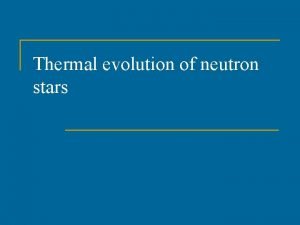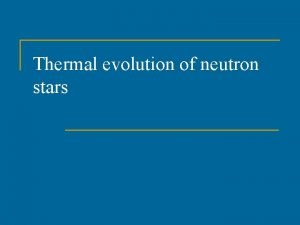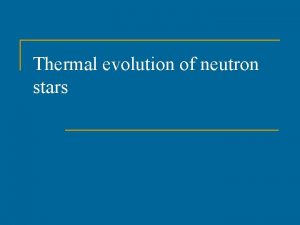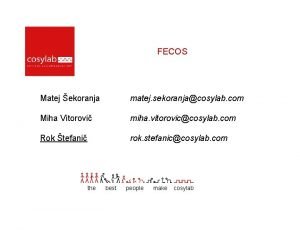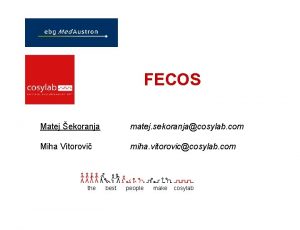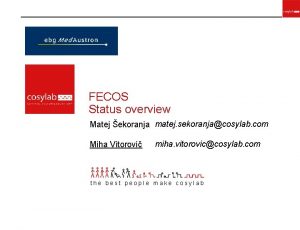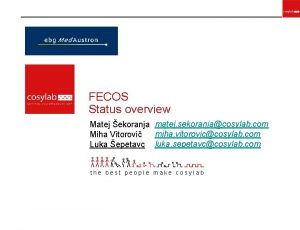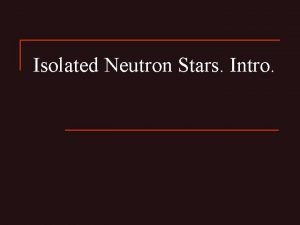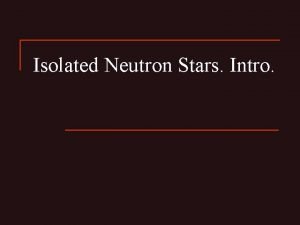Pions in Neutron Stars Evgeni E Kolomeitsev Matej

































![Given: • Eo. S • Cooling scenario [neutrino production] Mass of NS Cooling curve Given: • Eo. S • Cooling scenario [neutrino production] Mass of NS Cooling curve](https://slidetodoc.com/presentation_image/f3859acd5e30b1930567120555321853/image-34.jpg)





![Neutron star cooling [Blaschke, Grigorian, Voskresensky PRC 88 (2013)065805] Neutron star cooling [Blaschke, Grigorian, Voskresensky PRC 88 (2013)065805]](https://slidetodoc.com/presentation_image/f3859acd5e30b1930567120555321853/image-40.jpg)









![Nucleon shear viscosity [Shternin, Yakovlev, Phys. Rev. D 78 (2008) 063006] effective NN cross Nucleon shear viscosity [Shternin, Yakovlev, Phys. Rev. D 78 (2008) 063006] effective NN cross](https://slidetodoc.com/presentation_image/f3859acd5e30b1930567120555321853/image-50.jpg)


![Bulk viscosity collisional [Sykes, Brooker, Ann. Phys. 56(1970) 1] F 0 is the zeroth Bulk viscosity collisional [Sykes, Brooker, Ann. Phys. 56(1970) 1] F 0 is the zeroth](https://slidetodoc.com/presentation_image/f3859acd5e30b1930567120555321853/image-53.jpg)











![Neutron star model HDD Eo. S [Blaschke, Grigorian, Voskresensky, PRC 88 (13) 065805] based Neutron star model HDD Eo. S [Blaschke, Grigorian, Voskresensky, PRC 88 (13) 065805] based](https://slidetodoc.com/presentation_image/f3859acd5e30b1930567120555321853/image-65.jpg)

![1 S 0 neutron and proton pairing parameterizations from [Kaminker, Yakovlev, Gnedin, A&A 383(2002)1076] 1 S 0 neutron and proton pairing parameterizations from [Kaminker, Yakovlev, Gnedin, A&A 383(2002)1076]](https://slidetodoc.com/presentation_image/f3859acd5e30b1930567120555321853/image-67.jpg)

- Slides: 68

Pions in Neutron Stars Evgeni E. Kolomeitsev (Matej Bel University, Banska Bystrica, Slovakia LTP, JINR, Dubna, Russia )

Hideki Yukawa 1935 proposed a quantum of strong interactions 1940 professor in Kyoto University 1949 Nobel Prize in Physics 1953 the first chairman of YITP

1. Pion in neutron star, to be or not to be? 1. 1 Pionization. Chiral shield against it 1. 2 P-wave pion condensation. Short-range correlations 2. Neutron star cooling 2. 1 “Modified Urca” reactions (dynamical pions) 2. 2 Medium “Modified Urca” – a mechanism to understand NS cooling 3. R-modes and viscosity of NS matter 3. 1 R(Rossby)-mode instability. Age-P-dot diagram of pulsars. 3. 2 Shear viscosity. In-medium pions for bulk viscosity. 3. 3 Layered neutron star

Nucleon-nucleon interaction several scales are involved 2 p 2 r p 1 1 non-relativistic description vector mesons: mw, r~800 Me. V , correlated 2¼ exchange: m~200 -600 Me. V 1 -pion exchange: m¼=140 Me. V r~0. 24 fm r~0. 3— 1 fm r~1. 4 fm Equilibrium density of an atomic nucleus n 0=0. 16 fm-3 inter-nuclear distance (n 0)-1/3=1. 8 fm relativistic description +

QCD with light quarks

Pions – Goldstone bosons of chiral symmetry breaking chiral gap (½+) gradient couplings expansion in small pion momenta and masses parity partners (½-)

PIONIZATION OF THE NEUTRON STAR MATTER

Equation of state of nuclear matter symmetry energy There is a correlation among parameters: J, L, Ksym

If we assume some model for the density dependence of the symmetry energy Analysis of 36 RMF models gives [Dong, et al PRC 85, 034308 (2012)] More details and other relations in Tews, Lattimer et al, Ap. J 848, 105(2017)

Simple model for NS matter n+p+e+m matter Lightest negatively charged bosons: - minimum at k=0 Weak reactions start Pionization of neutron star matter

Chiral symmetry for pion-nucleon interaction isospin even and odd amplitudes Chiral symmetry: forward scattering amplitude: Weinberg Tomazawa theorem repulsive in neutron reach matter

29 Me. V<J<38 Me. V chiral shield against pionization Detailed analysis of the possibility of the s-wave pion condensation in Onishi, Jido et al, PRC 80, 038202 (2009)

P-WAVE PION CONDENSATION


Baym Migdal Scalapino 1974 Tbilisi

Tensor forces in NN interaction Resummed, enhanced pion exchange nucleon arrangement

Alternating-layer-spin configurations Ryozo Tamagaki Tatsuyuki Takatsuka 1972’-73’ 0 condensate tensor force contribution to the energy

PION CONDENSATION WITHIN THE FERMI-LIQUID THEORY

Fermi liquid theory system of strongly interacting fermions (no pairing) single-particle excitation mechanism quasiparticle-hole interaction on Fermi surface n n’ short-range long-range particle-hole propagator pole parts Landau parameters

density of states at the Fermi surface number of fermion types neutron matter: (1 parameter in each channel) nuclear matter: (3 parameters in each channel) In matter of arbitrary isospin composition these parameters are independent. Fermi-liquid renormalization is different for these parameters. small isospin disballance (2 parameters in each channel) In nuclear physics one uses also the normalization on the nuclear Fermi surface constant, independent of density Density dependence? Residual momentum dependence ?

There are relations between some Landau parameters and bulk properties of the system effective mass compressibility symmetry energy In general Landau parameter are to be fitted to empirical information (nucleus properties)

Solutions for zeroth harmonics keep only zeroth harmonics Lindhard function

Lindhard function Imaginary part Results of expansions depends on the expansion order: Temperature corrections

Scalar modes zero-sound modes I. g II. n pi “diffuson” u da n La stable mode III. unstable mode m a d

Fermi-liquid with pions pion with residual (irreducible in NN-1 and N-1) s-wave N interaction and scattering`` Part of the interaction involving isobar is analogously constructed:

Spin channel pure neutron matter Consider now the spin channel include the pion exchange explicitly similar solutions as in scalar channel s-wave and parts of polarization operator pion nucleon coupling constant If there is a “diffuson” solution Can change the sign at some momentum and density! Instability: pion condensation

Critical density of pion condensation Without short-range correlations (g’) the critical density of the pion condensation would be 0. 3 n 0 !

Spectrum of diffusive pion mode We search for a diffusive solution roton-like spectrum effective pion gap

Nucleon-nucleon interaction in dense matter based on a separation of long and short scales full pion propagator: enhancement of the amplitude dressed vertex: suppression Similar to Debye screening in plasma Landau-Migdal parameters of short-range interaction are extracted from atomic nuclei Poles yield zero-sound modes in scalar and spin channels known phenomena in Fermi liquid provided short-scale interaction can be reduced to the local one [Migdal et al. , Phys. Rep. 192 (1990) 179]

pion propagator for pion gap reconstruction of pion spectrum on top of the pion condensate LM parameters increase with density saturation of pion softenning no pion condensate amplitude of the pion condensate [Migdal, Rev. Mod. Phys. 50 (1978), Migdal, Sapershtein, Troitsky, Voskresensky Phys. Rept. 192 (1990)]

Vertex renormalization in FL Coupling of an external field to a particle pole parts of Green’s functions only “bare” (FL renormalized) vertex Effects: Reduce couplings. “A shield” against pion condensation Produce sound modes contributing to response functions Enhance reactions in some channels

NEUTRON STAR COOLING

Pulsar age Pulsar rotation period/frequency changes with time: e. m. wave emission grav. wave emission a angle between rotation a and magnetic axes e neutron star eccentricity initial period current period spin-down age: braking index: kinematic age: 1) age of the associated SNR 2) pulsar speed and position w. r. to the geometric center of the associated SNR 3) historical events Crab : 1054 AD Cassiopeia A: 1680 AD Tycho’s SN: 1572 AD
![Given Eo S Cooling scenario neutrino production Mass of NS Cooling curve Given: • Eo. S • Cooling scenario [neutrino production] Mass of NS Cooling curve](https://slidetodoc.com/presentation_image/f3859acd5e30b1930567120555321853/image-34.jpg)
Given: • Eo. S • Cooling scenario [neutrino production] Mass of NS Cooling curve

Neutron Star Cooling Data 3 groups: >103 in emissivity slow cooling intermediate cooling rapid cooling All groups can be described within one cooling scenario if there is a strong dependence of neutrino luminocity on the NS mass strong density-dependence of emissivity [Voskresensky, Senatorov 1986]

Neutrino emission reactions neutron star is transparent for neutrino CV – heat capacity, L - luminosity emissivity each leg on a Fermi surface / T neutrino phase space ´ neutrino energy

modified Urca (MU) standard pair formation-breaking process (PFB) exotic Direct Urca (DU) Direct Urca on pion (PU)

DU process schould be „exotics“ (if DU starts it is dificult to stop it) [Blaschke, Grigorian, Voskresensky A&A 424 (2004) 979] Eo. S should produce a large DU threshold in NS matter ! [EEK, Voskresensky NPA 759 (2005) 373]

enhancement factors w. r. t. MU emissivity medium MU reactions medium bremsstrahlung reactions vertex correlation function
![Neutron star cooling Blaschke Grigorian Voskresensky PRC 88 2013065805 Neutron star cooling [Blaschke, Grigorian, Voskresensky PRC 88 (2013)065805]](https://slidetodoc.com/presentation_image/f3859acd5e30b1930567120555321853/image-40.jpg)
Neutron star cooling [Blaschke, Grigorian, Voskresensky PRC 88 (2013)065805]

R-MODES IN NEUTRON STARS

Age-period diagram for pulsars The ATNF pulsar catalogue recycled pulsars stability of old pulsars? Young pulsars periods are much larger than the Kepler limit.

Rossby waves on Earth: in oceans and atmosphere The returning force for these wave is the Coriolis force Carl-Gustaf Rossby

R-mode instability of rotating neutron star and viscosity In a superdense system like a neutron star the Rossby waves are sources of gravitational radiation. 1998 it was shown by Andersson, Friedman and Morsnik showed that this radiation leads to an increase of the amplitude of the mode. so there is an instability Large R-modes can either destroy the star or the star stop rotating Viscosity of the dense nuclear matter can damp r-modes and save the rotating star

R-modes in rotating neutron star Consider a neutron star with a radius R rotating with a rotation frequency W and a perturbation in the form oscillation amplitude oscillation frequency for a<<1 (dominant modes for l=m=2) amplitude changes [Andersson Ap. J 502 (98) 708; Friedman, Morsink, Ap. J 502 (98) 714] gravitational radiation drives r-mode unstable viscous damping [Lindblom, Owen, Morsink, PRL 80 (98) 4843] If the r-modes are undamped, the star would lose its angular moment on the time scale of t. G, because of an enhanced emission of gravitation waves.

R-modes stability R-mode is unstable if the time >0 gravitational time scale damping rate due to the shear viscosity damping rate due to the bulk viscosity [Lindblom, Owen, Morsnik PRL 80 (98) 4843 Owen, Lindblom, Cutler, Schutz, Vecchio, Andersen PRD 58 (98) 084020] profile averages

Viscosity Euler equation: shear viscosity bulk viscosity Dissipation when there is a velocity gradient Maxwell (1860) kinetic theory calculations Nuclear matter: (naïve estimate) Dissipation after uniform volume change Units:

Lepton shear viscosity = electron + muon contribution low T, Fermi liquid results Lepton collision time tl is determine by lepton-lepton and lepton-proton collisions 1979 Flowers and Itoh: Important role of the phonon modification (plasmon exchange) for QCD plasma [Heiselberg, Pethick Phys. Rev. D 48 (1993) 2916] [Shternin, Yakovlev, Phys. Rev. D 78 (2008) 063006] leading terms for small T muon contributions are important

Lepton shear viscosity vs. neutron star mass Effects of proton pairing on lepton shear viscosity [Shternin, Yakovlev, Phys. Rev. D 78 (2008) 063006]
![Nucleon shear viscosity Shternin Yakovlev Phys Rev D 78 2008 063006 effective NN cross Nucleon shear viscosity [Shternin, Yakovlev, Phys. Rev. D 78 (2008) 063006] effective NN cross](https://slidetodoc.com/presentation_image/f3859acd5e30b1930567120555321853/image-50.jpg)
Nucleon shear viscosity [Shternin, Yakovlev, Phys. Rev. D 78 (2008) 063006] effective NN cross section FOPE: MOPE: modification factor [Bacca et al, PRC 80] Fermi liquid result

Neutrino shear viscosity With the temperature increase the neutrino mean free path decreases and for sufficiently high temperatures neutrinos become trapped inside the neutron star interior. Neutrino mean free path is determined by inverse MMU and PU processes weak T dependence contributes only in regions where neutrinos are trapped opacity radius is determined as

Lepton shear viscosity
![Bulk viscosity collisional Sykes Brooker Ann Phys 561970 1 F 0 is the zeroth Bulk viscosity collisional [Sykes, Brooker, Ann. Phys. 56(1970) 1] F 0 is the zeroth](https://slidetodoc.com/presentation_image/f3859acd5e30b1930567120555321853/image-53.jpg)
Bulk viscosity collisional [Sykes, Brooker, Ann. Phys. 56(1970) 1] F 0 is the zeroth harmonics of the dimensionless scalar Landau-Migdal parameter, F 0~ 1 nucleon relaxation time; small contribution

Bulk viscosity Energy dissipation of the mode: is neutrino emissivity Energy of the mode decreases if the pressure depends on an order parameter, which variation is delayed with respect to the variation of the density [Mandelstam, Leontovich, Zh. ETF 7(1937)438] soft mode order parameter is [Sawyer PRD 39, Haensel, Levenfish, Yakovlev A&A 357, A&A 372] lepton concentration relaxation time average over the perturbation period

for sum over various processes changing d. Xl direct Urca (DU); modified Urca (MU) [calculated with FOPE] or medium MU (MMU) [calculated with MOPE]; pion condensate Urca (PU)

Shear and bulk viscosities. Results MMU+DU

R-mode stability window shear bulk

Young pulsars 1. star is born hot and rapidly rotating (point A) 2. cooling time (heat transport!) >> spin-down time for max. r-mode amplitude 3. star moves along line AB because of r-modes 4. line BC, cooling and magnetic breaking Minimum point B must be above 62 Hz (PSRJ 0537 -6910)

Minimum of the stability window

LMXB recycled pulsars Rotation of LMXB pulsars cannot be explained. Shear viscosity is too small. Alternative mechanisms -differential drift in magnetic field [Rezzolla, Lamb, Shapiro] -weak reactions with hyperons +hyperon pairing [Jones; Nayyar Owen] -core-crust coupling [Bildsten, Ushomirsky, Levin] -saturation of r-mode amplitude at small values [Arras, Bondaresku, Wasserman] -non-linear decay of r-modes [Kastaun] - coupling to more stable modes [Gusakov, Chugunov, Kantor] -vortex flux-tube interactions [Haskell, Glampedakis, Andersson]

Soft bosonic modes in rapidly rotating systems dispersion laws of the low-lying bosonic excitations zero-sounds in normal fermionic system AB, Carlson-Goldman in fermionic superfluid What happens if the medium flows with a velocity v>vc? [Pitaevskii ’ 84; Voskresenky 93; Baym, Pethick 12] There appears a Bose condensate of excitations, which will carry a part of the momentum and the fluid will move with smaller velocity. differential rotation of the star pion and kaon p-wave condensates

Outer part of the core does not rotates. Crust rotates Minimal rc is determined by the size of the proton paring zone

Conclusions 1. Pion in neutron star, to be or not to be? • pionization? NO! • p-wave pion condensation. Yes!? But (g’ short-range correlations? , m. N*) 2. Neutron star cooling • medium “Modified Urca” – a mechanism to understand NS cooling 3. R-modes and viscosity of NS matter • moderate increase nucleon shear viscosity for small NS masses • partial trapping of neutrinos in the star core at T~2 x 10 – 10 K • large neutrino shear viscosity for T>2 x 10 • strong increase of the bulk viscosity 9 9 10

STAR MODEL
![Neutron star model HDD Eo S Blaschke Grigorian Voskresensky PRC 88 13 065805 based Neutron star model HDD Eo. S [Blaschke, Grigorian, Voskresensky, PRC 88 (13) 065805] based](https://slidetodoc.com/presentation_image/f3859acd5e30b1930567120555321853/image-65.jpg)
Neutron star model HDD Eo. S [Blaschke, Grigorian, Voskresensky, PRC 88 (13) 065805] based on Heiselberg-Hjorth-Jensen (HHJ) analytical parameterization of the microscopic Akmal-Pandharipande-Ravenhall (APR) Eo. S with A 18+ dv+U IX* forces n, p, e, m, matter binding energy per nucleon: scaling function: The scaling function makes Eo. S harder for n>5 n 0, but the Eo. S remains causal.

HDD Eo. S Friedman-Pandharipande-Skyrme Eo. S mass and radius proton and electron concentration thresholds of Direct Urca reactions thresholds of Modified Urca reactions on protons density profiles similar to the Tolman V solution
![1 S 0 neutron and proton pairing parameterizations from Kaminker Yakovlev Gnedin AA 38320021076 1 S 0 neutron and proton pairing parameterizations from [Kaminker, Yakovlev, Gnedin, A&A 383(2002)1076]](https://slidetodoc.com/presentation_image/f3859acd5e30b1930567120555321853/image-67.jpg)
1 S 0 neutron and proton pairing parameterizations from [Kaminker, Yakovlev, Gnedin, A&A 383(2002)1076] motivated by the calculations of Wambach, Ainsworth, Pines (1993) and Schulze, Cugnon, Lejeune, Baldo, Lombardo (1996) including in-medium modifications of the NN interaction BCS calculations with vacuum interaction, Vlow-k [Hebeler, Schwenk, Friman, PLB 648 (2007) 176] 3 P 2 neutron pairing [Schwenk, Friman, PR 92 (2004) 082501 (2004)] triplet paring is supperessed by medium-induced spin-orbit interaction. [Ding, Witte, Dickhoff, Dussan, Rios, Polls, ar. Xiv: 1406. 7789] long-range density and spin fluctuations preclude triplet pairing We will ignore triplet pairing

Profiles of critical temperatures for the singlet neutron and proton pairing
 Patricia place ses 24 pions sur une grille
Patricia place ses 24 pions sur une grille Anatomy of a star
Anatomy of a star The stars there are millions of stars in the sky
The stars there are millions of stars in the sky Matej potocar
Matej potocar Matej kovač
Matej kovač Matej baran
Matej baran Sodobni slovenski slikarji
Sodobni slovenski slikarji Matej sužnik
Matej sužnik Gimnazija jesenice
Gimnazija jesenice Matej pavšič
Matej pavšič Matej bel university
Matej bel university Kemarok
Kemarok Matej skočir
Matej skočir Matej accetto
Matej accetto Matej babej
Matej babej Dominik drozd
Dominik drozd Matej badin
Matej badin Matej pirnat
Matej pirnat Matej arnuš
Matej arnuš Kozk
Kozk Matej martinc
Matej martinc Hotot biały
Hotot biały Matej pavsic
Matej pavsic Matej cimerman
Matej cimerman Matej 3
Matej 3 Matej korvin cierny pluk
Matej korvin cierny pluk Kráľ matej a bača
Kráľ matej a bača Tajanstvena ruža antun gustav matoš analiza
Tajanstvena ruža antun gustav matoš analiza Mt 21,1-11
Mt 21,1-11 Matej ambroš
Matej ambroš Matej 18
Matej 18 Matej luburic
Matej luburic Vrtine
Vrtine Matej juric
Matej juric Matěj trochta
Matěj trochta Matej 25
Matej 25 Matej peria
Matej peria Matej kral a baca autor
Matej kral a baca autor Crab nebula neutron star
Crab nebula neutron star Neutron superhighway
Neutron superhighway Schwarzschild radius
Schwarzschild radius Masa del neutron
Masa del neutron Neutron star
Neutron star Proton neutron quarks
Proton neutron quarks Parity of neutron
Parity of neutron Proton neutron quarks
Proton neutron quarks Find the number of neutrons h
Find the number of neutrons h Neutron fission
Neutron fission Candela y neutron
Candela y neutron Neutron star
Neutron star Photon neutron
Photon neutron Isis neutron and muon source
Isis neutron and muon source Proton neutron
Proton neutron Chlorine neutron
Chlorine neutron Atoms family album
Atoms family album Symbol proton neutron elektron
Symbol proton neutron elektron Hydrogen isotope with 1 neutron
Hydrogen isotope with 1 neutron Neutron degeneracy pressure
Neutron degeneracy pressure Neutron
Neutron Mirjam van daalen
Mirjam van daalen Neutron activation analysis
Neutron activation analysis Siapakah penemu neutron
Siapakah penemu neutron Spallation neutron source
Spallation neutron source Binary neutron star
Binary neutron star Beta minus decay
Beta minus decay Neutron skin
Neutron skin Electron charge
Electron charge Co 60
Co 60 Neutron star
Neutron star

